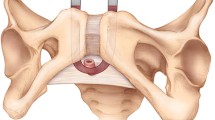Abstract
Medical malpractice as it relates to transvaginal mesh implantation adds another level of responsibility when deciding on surgical options to repair stress urinary incontinence or pelvic organ prolapse. As mesh is a viable option for repair, the informed consent process must involve a time commitment to discuss thoroughly the knowns and unknowns about mesh, and potentially must cover other aspects related to surgery: FDA classification of mesh, experience, potential off label usage, and conflicts of interest. A therapeutic alliance must be developed between physician and patient to allay possible fears about the intrinsic uncertainty of surgery. Proper risk assessment of the patient and pre-operative judgment as to when and if mesh implantation is appropriate are decisions that must be documented. Resolution of a conflict from a complication can be dealt with formally or informally. Above all, sharp skills, good communication, broad knowledge base of mesh surgeries, complication management, knowledge of guidelines, along with methodical documentation can mitigate or avert mesh-related litigation.
Similar content being viewed by others
References
http://www.fda.gov/MedicalDevices/Safety/AlertsandNotices/PublicHealthNotifications/ucm061976.htm, accessed May 17, 2016.
http://www.fda.gov/MedicalDevices/Safety/AlertsandNotices/ucm262435.htm, accessed May 17, 2016.
Bal BS. An introduction to medical malpractice in the United States. Clin Orthop Relat Res. 2009;467:339–47.
Anderson EE. Ethical principles for introducing device and/or mesh use into your practice. Clin Obstet Gynecol. 2013;56:232–7.
http://sufuorg.com/docs/news/augs-sufu-mus-position-statement-approved-1-3-2014.aspx, accessed May 17, 2016.
Bal BS, Choma TJ. What to disclose? Revisiting informed consent. Clin Orthop Relat Res. 2012;470:1346–56.
Bal BS, Brenner LH. Corporate relationships and increased surgeon liability risk. Clin Orthop Relat Res. 2013;471:1092–6.
Bal BS, Brenner LH. Corporate malfeasance, off-label use, and surgeon liability. Clin Orthop Relat Res. 2013;471:4–8.
Bal BS, Brenner LH. The judgment defense in medical malpractice. Clin Prthop Relat Res. 2013;471:3405–4408.
Brenner LH, Brenner AT, Horowitz D. Beyond informed consent. Clin Orthop Relat Res. 2009;467:348–51.
Robbennolt JK. Apologies and medical error. Clin Orthop Relat Res. 2009;467:376–82.
http://www.azleg.gov/ars/12/02605.htm, accessed May 17, 2016.
Sohn DH, Bal BS. Medical malpractice reform: the role of alternative dispute resolution. Clin Orthop Relat Res. 2012;470:1370–8.
6 Ways Docs Go Wrong With Informed Consent. http://www.medscape.com/features/content/6006323?src=wnl_edit_bom_weekly&uac=200985BY#vp_1, accessed May 17, 2016.
http://www.ultrariskadvisors.com/5-ways-healthcare-documentation-prevent-lawsuits/, accessed May 17, 2016.
Author information
Authors and Affiliations
Corresponding author
Ethics declarations
Conflict of Interest
Matthew Karlovsky declares no potential conflicts of interest.
Human and Animal Rights and Informed Consent
This article does not contain any studies with human or animal subjects performed by any of the authors.
Additional information
This article is part of the Topical Collection on Lower Urinary Tract Symptoms & Voiding Dysfunction
Rights and permissions
About this article
Cite this article
Karlovsky, M.E. How to Avoid and Deal with Pelvic Mesh Litigation. Curr Urol Rep 17, 55 (2016). https://doi.org/10.1007/s11934-016-0613-3
Published:
DOI: https://doi.org/10.1007/s11934-016-0613-3




